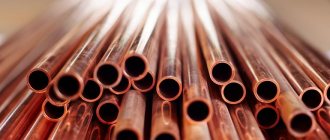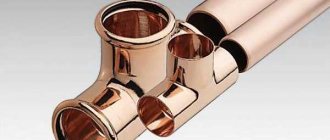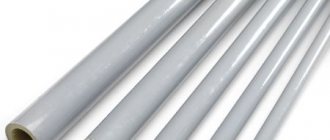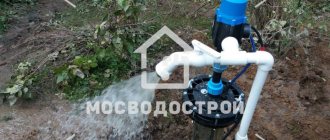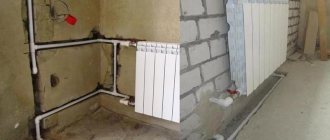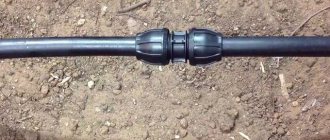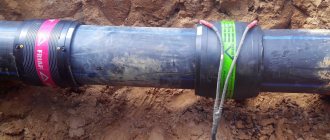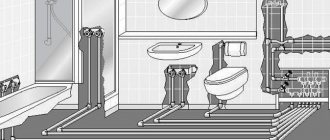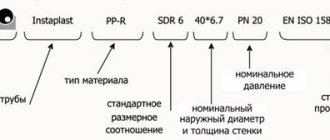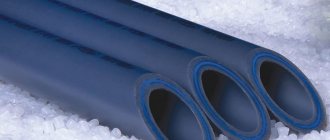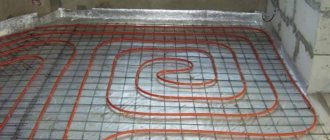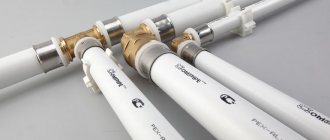A household water supply network assembled from rolled copper pipe elements is considered one of the most reliable. Of course, the development of such a highway is not a cheap pleasure. However, the high cost of the water supply system is compensated by its durability and other significant advantages.
In order to somehow save the budget of the water supply organization, you can install copper pipes yourself, having first studied the technology of the work. Do you doubt your own capabilities?
We will tell you what tools you need to prepare, we will describe step-by-step processes for assembling a copper pipeline by soldering, as well as using compression fittings. The following photo instructions and practical tips will help you avoid mistakes and set up a reliable utility network.
Nuances of installing copper lines
Plumbers, who have a set of tools and experience working with copper, perform a number of actions during the installation of copper pipelines:
- cleaning, calibrating, cutting;
- giving the desired shape;
- crimping, soldering, connection.
Each owner of an apartment or private house can perform the same actions with their own hands.
The key to high-quality installation of copper pipes using soldering is careful preparation for the process. The elements to be connected must be processed - cut to size, cleaned, adjusted to the joint, thereby creating conditions for high-quality installation
The main thing is to learn the nuances of technology and the secrets of producing such work. Each action requires an appropriate tool.
As a rule, a mechanic's tool kit includes:
- copper pipe cutter or hacksaw;
- files, sandpaper, rags;
- locksmith wrenches;
- gas key No. 1;
- manual calibrator, pipe bender;
- gas burner, flux, solder, fum tape.
The start of installation work is always preceded by activities aimed at calculating and drawing up a layout of the water supply or heating system.
Having a diagram for piping and connecting plumbing fixtures greatly facilitates installation work. The scheme allows you to accurately determine the financial costs of installation and rationally distribute the work time
Based on their diagram, the required number of copper pipes, their length, diameter, and the number of additional installation parts are calculated.
Installation of copper pipes using a threaded connection using crimp rings
This connection is detachable, however, if for some reason it has to be dismantled, the ring will need to be replaced. And so - after each next showdown.
The procedure for making such a connection is as follows:
1. Cut the pipe size you need. 2. If you are using PVC insulated pipes, remove the insulating layer at the end of the pipe. Using a sharp knife, make a cut and remove a piece of insulation by hand. 3. Using a file, remove the burrs that formed after the cut and remove the chamfer. 4. Prepare the fitting itself.
5. Place the union nut on the pipe first, and then the crimp ring.
6. Connect the nut to the prepared fitting and tighten the threaded connection. The nut must be tightened smoothly, first by hand, and then with a wrench when it does not work by hand. The ring will gradually crimp the pipe and the joint will be sealed.
If you are connecting a transition fitting from a steel pipe to a copper pipe, then use fum tape or tow with paint to seal the threaded connection. First screw the tape onto the thread, and only then screw in the fitting.
Tools for mounting elements
It is not always possible to cut a pipe without damaging the wall structure. The wall thickness of copper pipes up to a diameter of 28 mm is only 1 mm. Even the use of a disc pipe cutter for copper pipes does not fully guarantee an even cut. If wall disturbances are observed, a calibrator is used. This tool is used to calibrate (align) the pipe and socket.
Pipe cutters are available in manual, electric, pneumatic, and hydraulic types. Structurally, the pipe cutter is a mechanical clamp, where two rollers act as supporting elements. One of the rollers has a cutting edge.
The cutting process is carried out by sequentially pressing and rotating the pipe cutter around the pipe axis. The smoother and more often the pressing is performed, the better the quality of the pipe cut.
Copper pipe cutter for manual use. This tool produces a high-quality, even pipe cut. But at first it is advisable to take a training course - to learn the technology of cutting on unnecessary pieces of pipes
Installation work is often accompanied by bending of copper pipes. A high-quality, even bend of any radius helps create a tool called a pipe bender. There are two types of copper pipe benders - spring and mechanical.
The first tool has a simple but effective design. Designed for bending small diameter pipes. The second type includes several design varieties.
A spring pipe bender is made in the form of a long casing that fits onto a copper pipe. One end of such a casing is slightly widened for greater ease of use. The copper pipe placed in such a springy shell is bent by hand without the risk of jamming at the bend.
Disadvantages - the bending radius has to be checked by eye; for a specific pipe diameter you need your own spring pipe bender.
Spring pipe bender in action. This device is convenient for bending small diameter pipes in a wide range of radius configurations. At the same time, the spring bender provides quite acceptable bending quality
Mechanical pipe benders (lever, segment, crossbow, hydraulic) allow you to bend pipes of different diameters (from 10 to 125 mm). Copper pipes of large diameters are usually bent using a segment bender or a hydraulic pipe bender. The bending angle when working with such devices can be 180°.
What is better copper or polypropylene pipes?
For an objective comparison, let’s consider the basic indicators of both types of materials, which are typical for all water pipes:
- Operational properties. Copper, unlike polymer materials, is not susceptible to the destructive effects of chlorinated tap water. Chlorine is a strong oxidizing agent that corrodes plastic, and on the internal surfaces of copper pipes it forms a thin protective layer - a patina, which significantly increases their service life. Ultraviolet radiation and sub-zero temperatures are detrimental to plastic, while copper is resistant to exposure to sunlight when the temperature drops its walls expand without loss of integrity.
- System reliability. The connection points of plastic pipeline elements are less reliable than copper ones.
- Lifetime. Copper and polypropylene pipelines can be used for at least 50 years.
- Price. The cost of copper products is high, this is due to the high cost of primary copper and the complexity of the production process. Of course, polypropylene pipes are several times cheaper. But, when assembling plumbing systems, polypropylene fittings are required, the cost of which is much more than copper fittings. In addition, plastic pipelines require additional elements that increase their reliability.
As a result, it turns out that the cost of copper water supply is generally lower than that of plastic.
Characteristics of copper water supply
The durability of copper water pipes is to some extent due to the fact that the chlorine contained in the water, in reaction with copper, contributes to the formation of a thin oxide film on the inner surface. This film additionally protects the pipe wall from the negative influence of the pumped medium.
Copper is also considered the optimal material according to the results of sanitary and bacteriological studies. This metal has a bacteriological effect, for example, against the staphylococcus virus.
The created pipeline system based on copper hoses is usually insulated. There are materials specifically designed for use with copper pipes. Insulation saves heat and eliminates the formation of condensation
Copper has a high thermal conductivity coefficient. This point forces us to take measures aimed at isolating pipes from the external environment.
An uninsulated cold water supply system in the summer can create a serious problem with the collection and disposal of condensate. Uninsulated hot water pipes experience significant heat loss. When installing copper pipe networks with your own hands, you should take these points into account.
Material characteristics
A copper water pipe is a type of rolled copper metal, which is a long-shaped hollow piece with a round cross-section and uniform wall thickness. Available in rods with lengths from 1 m to 6 m or coils of 15, 25 and 50 m.
The diameter of the products varies from 6 to 267 mm, wall thickness from 0.5 mm to 3 mm. Although copper tubing has a thinner wall than steel, its internal diameter is larger, so it can withstand the same operating pressure as steel products with the same external diameter.
The technical characteristics of copper pipes depend on the properties of the copper grade. Usually, pure copper or its alloys are used in production, to which a small amount of alloying components is added (M1p, M1f). The type and amount of impurities in alloys has a significant impact on the mechanical, technological, mechanical and operational characteristics of pipes.
The addition of zinc, tin, iron and lead increases the strength, elasticity and flexibility of the material, acidification with phosphorus increases the corrosion resistance of this metal. To increase mechanical resistance and anti-friction properties, aluminum and beryllium are used. To eliminate the negative effects of unwanted impurities, manganese is introduced into the alloy composition.
Conclusions and useful video on the topic
You can learn how to install a copper water supply from the following video:
Quality, reliability, durability – plumbing and heating systems endowed with these properties often delight apartment and house owners if copper is used for installation work.
Indeed, when there is confidence that there are no leaks and are not expected in the future, that there are no gusts even in severe winter, this means that a system of copper pipes is installed in the house.
Do you have anything to add or have questions about the technology for installing copper pipes? Please leave comments and participate in discussions about the post. The contact form is located in the lower block.
Advantages of copper pipes
Among the most significant advantages that are inherent in copper products are their high resistance to oxidation, strength and durability, incomparably greater than that of polymer analogues, as well as convenience and ease of installation.
From the point of view of the feasibility of preferring copper water pipes, their use is justified in cases where frequent and sudden temperature changes are expected, as well as high pressure in the network.
There are two technologies for connecting copper pipes: using a threaded connection with a crimp ring, and also by soldering.
Moreover, the use of crimp rings allows even a non-professional to complete the job with ease. All that is required is a set of standard wrenches that will be used to tighten the connection. When selecting a suitable fitting, you need to take into account the original diameter of the copper pipe.
Installation of copper pipes by soldering allows you to make a very strong and reliable connection, however, such work will require some practical skills from the master, as well as compliance with safety precautions.
To install a water pipe made of copper pipes, you will need the following tools:
- Metal hacksaw or pipe cutter. You will need to frequently cut the pipes during installation and adjust them to the desired size. If you use a hacksaw (if you are not a professional plumber and do not deal with pipes very often, you don’t have to buy a pipe cutter), then do not forget to install a new blade.
- Manual calibrator. Needed, accordingly, to calibrate the pipes.
- A torch designed specifically for soldering copper pipes. If you are going to connect pipes using a threaded connection using a ferrule, then you naturally do not need any torch. The burner should include hoses that connect to the cylinder. If this is your first time using the burner, please read the operating instructions carefully.
- Spanners. They are useful when installing any water supply system, not just copper. If you connect copper pipes with a threaded connection, then you won’t be able to do without a wrench.
- Pliers.
- File for deburring.
- Fine sandpaper to remove oxide film.
DIY installation of copper pipes for water supply and heating systems
Copper pipes are the most acceptable option for organizing a water supply network.
The presence of various impurities in water does not affect the structure of such products. Due to their properties, they can be actively used in heating, air conditioning and gas transmission systems. The pipes are connected during installation using compression fittings or soldering. Installation of copper pipes can be done using a compression fitting
Features of copper pipes
Important advantages of communication networks made of copper are high strength, corrosion resistance, flexibility and ductility, and durability. An important feature of copper is its ability to eliminate some bacteria, which prevents them from multiplying and settling on the inner surface of the pipe.
When installing a pipeline with your own hands, it is necessary to take into account the following factors for choosing copper pipes:
- purpose of the pipeline;
- temperature of the substances that will be transported;
- pressure in the water supply or heating system;
- pipe size;
- the presence of an insulating layer.
The disadvantage of copper pipes is their low compatibility with products made from other materials.
Copper pipes are the best option for plumbing
The most important characteristic that determines the technical parameters of the pipeline and the selection of the necessary fittings is the diameter of the copper pipe. In the construction of household systems, the most common sizes are:
| Pipe diameter, mm | Wall thickness, mm |
| 10-28 | 1 |
| 35-54 | 1,5 |
Important! With a smaller thickness, copper products have a much higher operating pressure than their steel counterparts.
More bulky systems require the installation of large copper pipes.
Areas of use of copper pipes
Due to the ability to work with high-temperature liquids, copper pipes are widely used in heating systems.
This is especially important in single-pipe circuits, where in order to maintain the temperature of the last radiator at about 70 °C, in the first it must be at the level of 120 °C.
The maximum operating temperature for polymer products is 95 °C, while copper pipes can transport liquids with a temperature of 300 °C.
A pipeline made of this material can withstand pressure of 200-400 atm. The soldered joint does not lose its tightness.
Soft copper pipes can easily withstand up to 4 freeze/thaw cycles. Plumbing copper is resistant to chlorine. Being a strong oxidizing agent, it promotes the formation of an oxide protective film on the inner wall of the copper pipe, which increases the service life of the pipeline.
You can do a hidden laying of a copper pipeline with your own hands if there is a polymer layer on it, which will prevent the flow of stray currents. It is also necessary to avoid combinations of materials in the system that could lead to galvanic corrosion. When connecting, for example, copper to aluminum, brass adapters are used.
Copper pipes are often used to create a heating system
Tools required for installation
The main operations that are performed during the installation of copper pipes include cutting, bending, assembling components and connections, soldering, pressing, and welding. Additionally, calibration and cleaning of the ends, removal of burrs and burrs, application of flux followed by removal of its residues, etc. are carried out.
Note! Before starting work, a water supply diagram is drawn up indicating the number of required parts and pipe sizes.
To install copper pipes with your own hands, you will need the following tools:
- pipe cutter or hacksaw;
- manual calibrator;
- burner for soldering copper pipes;
- spanners;
- file.
The materials required are copper pipes, fittings for them, tape that seals the threaded connection, flux and solder.
Before installation, you need to prepare the necessary sections of copper pipes by cutting them with a pipe cutter. If a hacksaw is used for these purposes, it is important to install a new blade. Products are checked for integrity; damage, kinks, flattened areas, etc. are unacceptable.
To understand what tools are needed, you should decide on the method of connecting the pipes
A torch is needed if the connection will be made by soldering. To connect to the cylinder with it, the kit must include hoses. Wrenches are required for threaded connections of copper pipes. The burrs are removed with a file.
Features of installation operations
The pipe cutting operation is simple and fast. Attention should be paid to maintaining perpendicularity to the pipe axis and the cutting edge. The permissible deviation of the cut plane from perpendicular to the pipe axis should be less than:
| Outer diameter, mm | Cutting bevel, mm |
| 6-18 | 2 |
| 22-42 | 3 |
| 54-76 | 4 |
| 88-108 | 5 |
The most common are disc pipe cutters. When using them, it is better to increase the number of revolutions than to apply more force.
Sometimes, when cutting soft copper pipes, their ends are deformed, as a result, the installation gap changes and the capillary effect is disrupted. To restore the shape, the ends of the pipes are calibrated.
First, the inner diameter is calibrated, then the outer diameter.
An influx of metal during soldering - burr - can form inside the copper pipe, which will increase the fluid resistance during operation. In this case, it must be removed.
Due to its ductility, copper pipes can be connected using a socket method without the use of fittings or couplings. It is applicable only for pipes with equal diameters and in heating and water supply systems with water temperatures up to 110 °C. Obtaining a bell is possible using special tools.
To bend the pipe, you need to use a pipe bender
When bending a copper pipe with a diameter of up to 15 mm, its radius must be at least 3.5 diameters, for diameters over 15 mm - four diameters. When bending by hand, the permissible radius is equal to 8 workpiece diameters, so a pipe bender is used to bend copper pipes to a large radius.
Threaded connection of copper pipes
When installing copper pipes with crimp fittings, dismountable connections are obtained, which are not absolutely reliable and require monitoring during operation.
This connection is designed for a lower permissible pressure and requires periodic tightening. First, a piece of pipe of the required length is cut off. If copper pipes with an insulating layer are installed, it is removed from the end of the product.
To do this, an incision is made with a sharp knife and the insulation is removed. Next, the burrs are removed from the end of the pipe with a file.
The union nut is first put on the pipe, and then the crimp ring. After connecting the nut and the compression fitting, the threaded connection is tightened. First you need to do this smoothly, then use the key. During this process, the ring compresses the copper pipe and the joint is sealed.
The threaded connection can be used in easily accessible areas of the pipeline
If transition fittings from steel to copper pipes are used, sealing is done using fum tape. It is screwed onto the thread, and then the fitting is screwed in.
Important! Connection with compression fittings is advisable in places where it is possible to check its tightness.
Features of soldering connection
Soldered connections are used in situations where the installation of water supply or heating pipes is carried out in walls, floors, or in other cases in which access for visual inspection of the integrity of the connection is impossible.
The method is based on the capillary effect, due to which the solder is evenly distributed over the cross-section of the pipe, regardless of its position. To create it, special fittings are used, which have diameters that differ from the diameters of the pipes by a certain value. The recommended gap for soldering over an open flame is 0.1-0.15 mm.
For connections using capillary soldering, solders and fluxes are used. There are low-temperature and high-temperature soldering methods.
Soft (low-temperature) soldering is used for networks for transporting gaseous and liquid media with an operating temperature of no more than 110 °C. It is suitable for connecting pipes with a diameter of 7-110 mm. Products with a wall thickness of more than 1.6 mm and a diameter above 110 mm can be joined by welding.
For soldering you will need a gas torch and special wire (solder)
Hard (high-temperature) soldering is almost never used when installing a pipeline with your own hands. It is applicable for connecting pipes in systems where operating conditions involve significant temperatures.
DIY soldering process
The soldering process is performed in the following sequence:
- A piece of pipe of the required size is cut off.
- At its end, the thermal insulation is removed and the burrs are removed.
- The soldering area and fitting are cleaned from the oxide film with sandpaper.
- The dust is wiped off and flux is applied to the surface.
- The end of the pipe is inserted into the fitting, leaving a gap of no more than 0.4 mm.
- The joint is heated with a torch and the seam is sealed with solder.
If there is no burner, then a blowtorch is suitable for heating. The movement of the flame must be uniform so that individual areas do not overheat. Solder for soldering copper pipes must have a minimum melting point.
Helpful advice! To check that the joint is heated sufficiently, you need to touch it with solder. If it melts, then the required temperature has been reached.
In order to seal the seam in the gap between the pipe and the fitting, solder is introduced. It is important to ensure that the compound is fixed and immobilized until it crystallizes completely.
Thus, the installation of copper pipes can be done with your own hands, if you take into account all the rules and recommendations. A plumbing system made from such materials is durable and reliable.
Types of fittings
Threaded fittings
They have long been used to connect pipes. They have a thread inside that allows them to be screwed onto a pipe, providing a connection.
https://www.youtube.com/watch?v=N9QwpYEQpUw
Of course, it can be noted that do-it-yourself installation of metal-plastic pipes for heating does not contain such intricacies, but copper pipes for heating are simply not used, this would not be at all economical.
Solder fittings
Copper fittings allow you to connect pipes using capillary soldering. Solder is used for this. There is a small wire on the internal thread; before the fitting is put on the pipe, it is coated with flux. The joint is then heated with a torch until the solder becomes liquid and fills the gap between the pipe and the fitting. The traditional method of joining copper pipes is capillary soldering. The gap should be minimal to 0.4 mm. Fittings intended for capillary soldering are made of the same material as the pipes themselves. Such fittings include bends, angles, tees, plugs, couplings, etc.
Compression fittings
With this connection method, fixation is achieved by pressing the ring. For connections of this type, a simple tool is used and the design is collapsible. They are quite convenient to use in hard-to-reach places, but such fittings often leak.
Press fittings
Variety of Copper Fittings
Such fittings consist of a sleeve and a body. The sleeve is clamped around the pipes. This design is non-removable and ensures maximum reliability. Crimping tools are available for fittings of different diameters. By sequentially crimping the pipe, you can obtain a reliable, durable, permanent connection between the fitting and the pipe. Copper pipelines can be installed three times faster thanks to a special instant cold press connection technique. The connection is safe because no heat is required.
